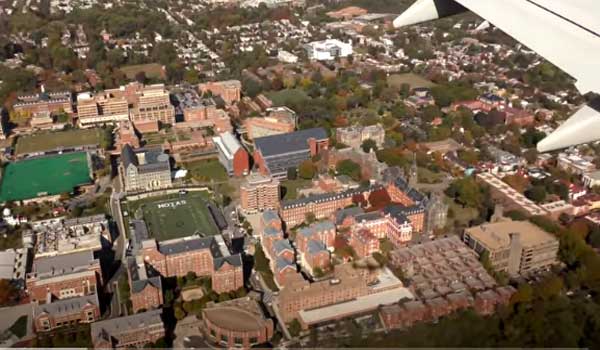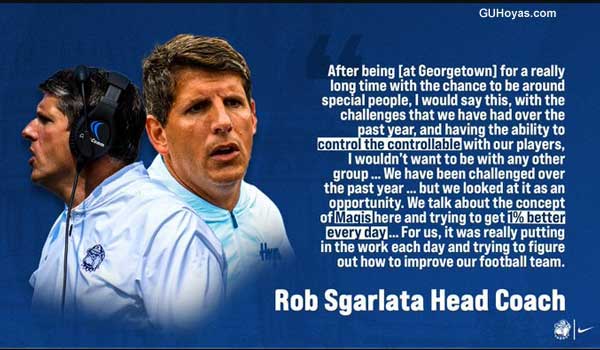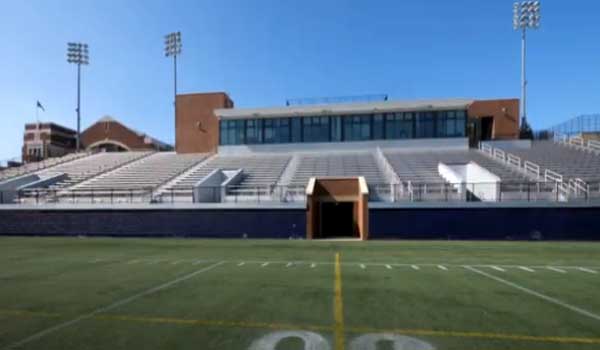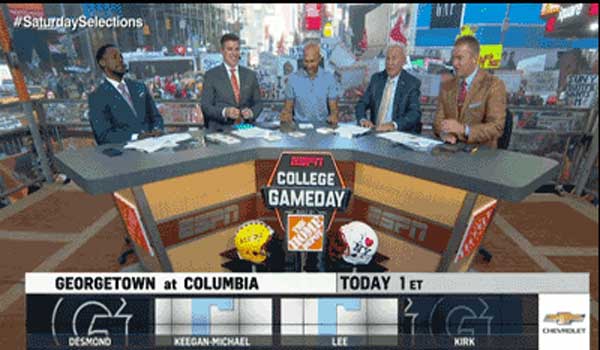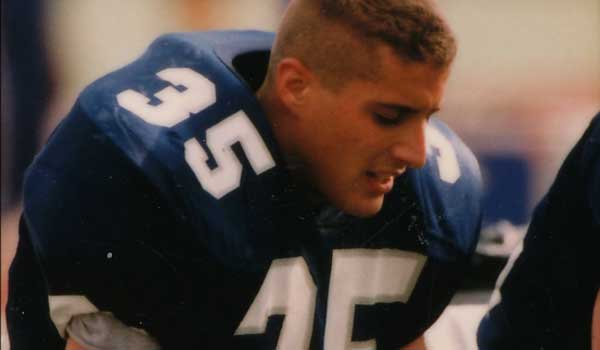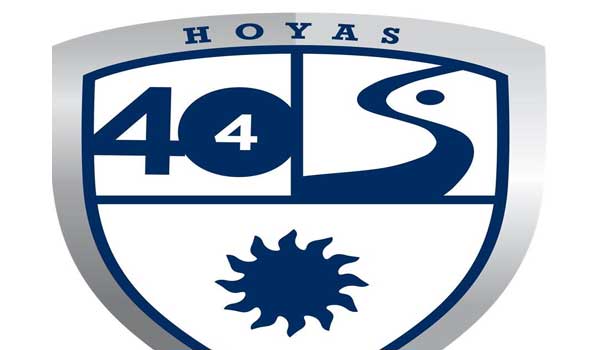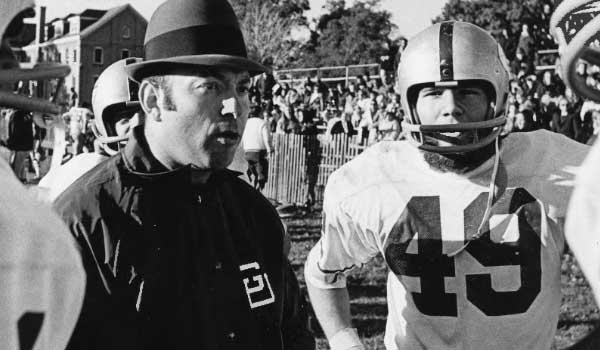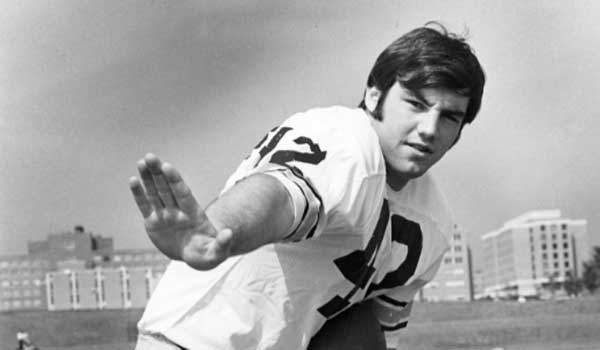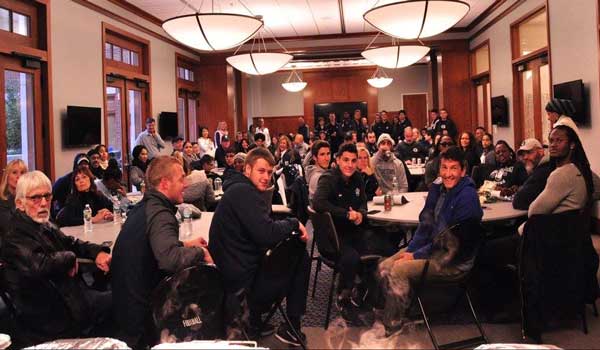News Analysis: William & Mary's Move

It was not a year ago that news of the arrival of the University of Richmond to the Patriot League foretold a tectonic shift in the regional football landscape. If so, Friday's announcement of a ninth PL school is the first of two earthquakes to reshape the landscape of Eastern football.
But this took years. The move by William & Mary was, by contrast, mere weeks. What happened? And what does this mean for Georgetown?"Once upon a time, Patriot League members did not offer athletics-based financial aid and had little hope of competing nationally," wrote columnist David Teel. "[In 2012] the dinosaurs realized that athletic scholarships do not equate to academic decline, and their pivot to modern times enhanced Patriot League football, witness its subsequent playoff encounters with CAA programs.
"In the last 10 postseasons, Patriot teams are 5-5 versus the CAA. In 2015, Patriot champ Colgate defeated the CAA's New Hampshire and JMU en route to the quarterfinals, and last year Lehigh rallied for a playoff victory at Richmond. This one week after the Spiders had routed W&M 27-0 to finish 8-0 in the CAA."
The word "Richmond" is at the center of this move.
In hindsight, Richmond's move to the PL was surprising but not altogether shocking. Despite its roots in the capital of the Confederacy, the school has longed looked north for students and within athletics. It left the Southern Conference in 1975 in search of a major college home and, finding none for the next decade, joined a league literally called the Yankee Conference. It joined the Atlantic 10 for basketball and most of its sports over 20 years ago, and seemed a more plausible fit for the PL's somewhat parochial view of college football at the time.
Twenty years earlier, however, UR alumni were in open revolt over a plan being floated to join the Patriot League at the conclusion of the A-10's sponsorship of the football conference. "The decision [to join CAA football] came after a frantic week that began with a Richmond Times-Dispatch article that revealed that the board of trustees was considering...a move to the non-scholarship Patriot League," wrote the Richmond Collegian. "Within days, flyers had been posted, petitions had been circulated and the overwhelming opinion of the student body, alumni and supporters became apparent they wanted Richmond football in the CAA. According to a university representative cited in the Times-Dispatch article, the administration office received more communication about the proposed league change than the tuition increase."
"If the school does want to move to the Patriot League, it seems as if they are just trying to get rid of football in the long run," said Stacy Tutt, its all-conference quarterback.
Two decades later, no such opposition. Football scholarships made the PL model more palatable, as did a league wide move to FBS guarantee games (except Georgetown, of course) that was comparable to CAA football aspirations. The ongoing loss of rivalries that had dated to the Yankee Conference was no small factor: UConn, UMass, Delaware, and James Madison were gone, and the likes of Bryant, Campbell, North Carolina A&T and Hampton were poor substitutes.
"It was very obvious to me, [that] it's not the CAA that we used to know, and it's not the Patriot League that we used to know."
--Former W&M coach Jimmye Laycock (1980-2018)
"I think it comes down to a couple of things for us," said W&M athletic director Brian Mann. "First is, we wanted to be connected to the University of Richmond and play them in football every year, and when we can do it the last Saturday before Thanksgiving with the hopes that that game will have some postseason implications, that's a place where we want to be."
Mann added the missing piece to the puzzle: by adding Richmond, the PL was, in his words, "serious about becoming a nationally relevant football conference and building on the successes they've already had. And Richmond going in, without reducing anything that they were doing in football, we took notice of that. And so when the conversation started up not long ago, we had a different perspective on how the Patriot League was viewing their future."
The Newport News Daily Press compresses the timeline even further. "As outlined by Mann, the Patriot-W&M courtship began only a few weeks ago, the process streamlined by mutual interest and a football-only focus. A quick and enthusiastic endorsement from Mike London, Laycock's successor as head coach, made Mann's sales pitch to other constituents even easier."
"For us it's great because it's the same number of conference games we're used to playing," Mann said, "and our schedule is built that way for the next few years."
In one sense, Richmond jumped into the PL pool and called over to the Tribe: "Jump in, the water's fine". This isn't the Patriot League that sneered at the playoffs, that eschewed scholarships, or would aspire to play nothing more than Ivy League teams in their off-weeks. In the 2025 season, PL teams not named Georgetown will play the likes of Air Force, Boston College, Northern Illinois, Oregon State, and Syracuse this fall, not dissimilar to Richmond playing North Carolina nor William & Mary at Virginia. For a William and Mary program which also has games with Duke, Stanford, and Wisconsin on its plate through 2030, this was an affirmation that a move alongside Richmond, preserving its signature rivalry, would not be in vain.
Conference moves are not easy, of course, because they affect the college as a whole, endure significant exit fees, and can be institutionally acrimonious. How did William & Mary pull it off? Someone did their homework.
Yes, W&M is a member of the Coastal Athletic Association and has no interest, for now, in moving its teams elsewhere. The reported exit fee to leave the CAA is $1 million, a pittance compared to $30 million and 27 months advance notice for the Big East Conference and over $100 million in the power football conferences, but no small sum, either.
But CAA football isn't the CAA, at least not exactly. The CAA is a successor in interest to the conference previously sponsored by the A-10 and the former Yankee Conference and was always a separate entity, which allowed schools like Richmond, Villanova, New Hampshire, et al. to play football but not move all its sports there. A reported exit fee of just $250,000 for schools under the CAA football entity is more than manageable--a $420,000 guarantee fee for W&M's game at Virginia on September 13 covers the entire cost and then some.
What does a move offer William & Mary? Playoff opportunities, sure. Marginal savings on travel? Yes. What is really protects is 1) the Richmond rivalry and 2) a hedge against further instability in the CAA, where a house divided between the likes of Maine, New Hampshire and Rhode Island and a southern flank of Campbell, Elon, and NC A&T is increasingly unstable.
If the proverbial ground shook the Tidewater region, rest assured it was felt in McDonough Gymnasium, too. The arrival of two very strong football programs to a league that has not changed in over 20 seasons does not go unnoticed, no less so for a Georgetown program that has long been in its own peculiar orbit for years. It's the school that aspires to be Penn State in one sport (men's basketball) but is closer to Penn in 29 others. It's the only non-scholarship football program within a Division I scholarship conference.
Some of this was tolerated to the fact that Georgetown was seen by some as an insurance policy of sorts to maintain a minimum number of PL schools for playoff consideration and that, while the Hoyas don't win very often, they play by the rules and are a nice addition to the annual schedules. But as the quotes above suggest, Richmond and William & Mary are coming to compete, and to win. It's raising the game for Holy Cross and Lehigh, Colgate and Fordham and at the very least, may be a walk-up call at Lafayette and Bucknell. How this changes Georgetown, if at all, bears watching.
More in part two of the series.
William & Mary Joins Patriot League

In an unexpected announcement, the College of William & Mary has announced it will join Patriot League football in the 2026 season.
"We are excited to accept this invitation from the Patriot League as football members," said W&M president Katherine A. Rowe in a news release. "It is a delight to be president of a university with such a robust commitment to excellence in Division 1 sports. We are constantly looking at how best we can support students who compete in every one of our sports. This move is a perfect fit for our football program, and we look forward to the future."The college will remain in the Coastal Athletic Association (CAA) for its other sports.
William and Mary has been a part of CAA football since its original incarnation as the Yankee Conference in 1993. Seven years earlier, W&M was briefly a charter member of the Colonial League, now known as the Patriot League, but bowed out before the first season to retain scholarship football. The addition of scholarships in the PL renewed interest in W&M as a future member given its academic reputation, but W&M remained steadfast to the CAA. recent changes in that conference, including the departures of Delaware and James Madison, and the subsequent move by rival school Richmond to the PL this season, changed the equation.
"Moving football to the Patriot League is a strategic decision that will align our program with other schools that play competitive football in a strong FCS conference with student-athletes who achieve at the highest level," said athletic director Brian Mann. "Joining a conference with Richmond, with whom we have a football rivalry encompassing 135 games, is another tremendous benefit. We can look forward to closing each football season with Richmond in the battle for the Capital Cup in front of cheering alumni, friends, and fans."
The annual meeting with Richmond, known as the "Oldest Rivalry in the South", has met 135 times since 1898. The rivalry was at risk when Richmond announced its move to the PL last year. A series of early season games were rescheduled through 2030 between the schools, but a move to the PL will likely return the game to its traditional date on the last Saturday of the regular season, much as rivalries such as Harvard-Yale and Lehigh-Lafayette enjoy.
"I think it comes down to a couple of things for us," Mann told the Richmond Times-Dispatch. "We wanted to be connected to the University of Richmond and play them in football every year, and when we can do it the last Saturday before Thanksgiving with the hopes that that game will have some post season implications, that's a place where we want to be...[The Patriot was] serious about becoming a nationally relevant football conference and building on the successes they've already had. And Richmond going in, without reducing anything that they were doing in football, we took notice of that. And so when the conversation started up not long ago, we had a different perspective on how the Patriot League was viewing their future."
W&M arrives with a solid football tradition, with nine CAA championships, 12 nationally ranked seasons, and a 29-7-0 all time record versus the seven current PL teams, minus Richmond. Georgetown owns a 2-1-0 record versus the Tribe, but the two schools have not met since the 1934 season.
In a statement from the CAA, its conference commissioner remarked that "Today, I was informed of William & Mary's decision to depart the CAA Football conference at the conclusion of the 2025 season....CAA Football remains committed to competing at the highest level and continuing its long-standing history of success. CAA Football will continue to make decisions that move the conference forward by creating both a competitive and sustainable model." Members for the 2026 season include Albany, Bryant, Campbell, Elon, Hampton, Maine, Monmouth, New Hampshire, North Carolina A&T, Rhode Island, Stony Brook, Towson, and Villanova.
2025 Season Finale At Fenway Park

Officials at Georgetown and Holy Cross announced that the Nov. 22 game between the schools has been moved to Fenway Park in Boston.
NEWS RELEASES
Holy Cross has not played at the park since 1956, while Georgetown last played there in its memorable match with #5 Boston College in 1940 before 35,000 in attendance."Our players, coaches, staff and alumni are extremely excited to compete at one of the country's most iconic stadiums," said head coach Rob Sgarlata. "I am excited to play in front of the Hoya faithful in this incredible environment against Holy Cross."
"We are excited to work with Fenway Park Events to welcome families, fans and friends from both schools to create a once-in-a-lifetime memory," said Holy Cross athletics vice president Kit Hughes. "Fenway Park is synonymous with rich history and tradition, home to one of the best teams and some of the best moments in professional sports history, and we are thrilled for the chance for our student-athletes to play in such a unique environment."
This is Georgetown's first visit to Boston since it defeated Boston State (now UMass-Boston) 7-6 to open the 1973 season. Holy Cross' last game at Fenway took place in a 7-0 season finale over Boston College before the Eagles moved to Alumni Stadium on-campus.
More on the game to follow.
